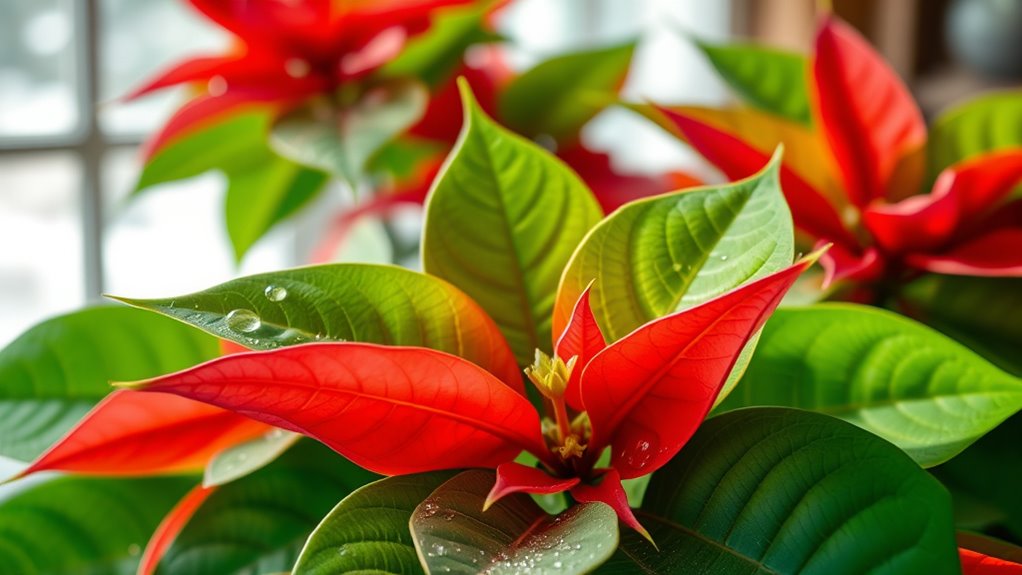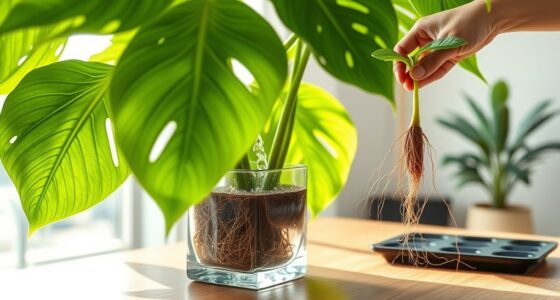To keep your poinsettia alive past the holidays, make sure it gets at least six hours of bright, indirect light daily and maintain temperatures between 60°F and 70°F. Water only when the top inch of soil feels dry, and boost humidity with trays or misting. Prune and repot as needed, and in October, give it a 6-8 week dark period to encourage reflowering. Keep exploring for more tips to help your plant thrive year-round.
Key Takeaways
- Provide 6+ hours of bright, indirect sunlight daily and maintain temperatures between 60°F-70°F.
- Water only when the top inch of soil feels dry, ensuring proper drainage and room temperature water.
- Prune stems in early spring and regularly pinch new growth to promote a bushy shape.
- Begin a dark/light cycle in October: 12-14 hours of darkness nightly for 6-8 weeks to reflower.
- Increase humidity with trays or misting during winter to prevent leaf drop and dry air damage.
Ensuring Proper Light and Temperature Conditions
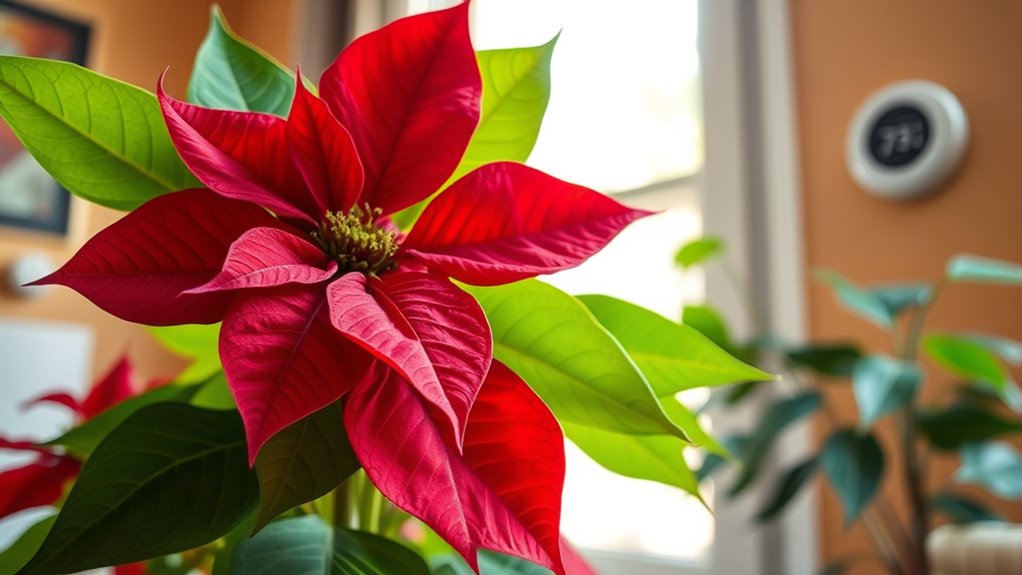
To keep your poinsettia vibrant and healthy, it’s essential to provide the right light and temperature conditions. Place your plant where it can receive at least 6 hours of bright, indirect sunlight daily, such as near southern, eastern, or western windows. Avoid direct sunlight, which can scorch leaves. Keep indoor temperatures between 60°F and 70°F to prevent leaf drop and fading. Temperatures outside this range can cause stress, moisture loss, and leaf drop. Stay away from cold drafts from open windows or vents, as they can harm your plant. Also, avoid placing your poinsettia near heat sources like radiators or fireplaces, which can damage the foliage and lead to unnecessary stress. Maintaining proper light and temperature helps your plant stay healthy and colorful. Proper environmental conditions are crucial for the longevity of your poinsettia. Additionally, consistent temperature control prevents sudden changes that can cause leaf drop or color fading. Ensuring the right air circulation can also help prevent issues like mold or pests that may affect your plant’s health. Incorporating suitable ventilation systems can further promote overall plant health and reduce humidity-related problems, which is especially important given the increased focus on lifestyle and home environment management.
Watering and Humidity Management for Longevity
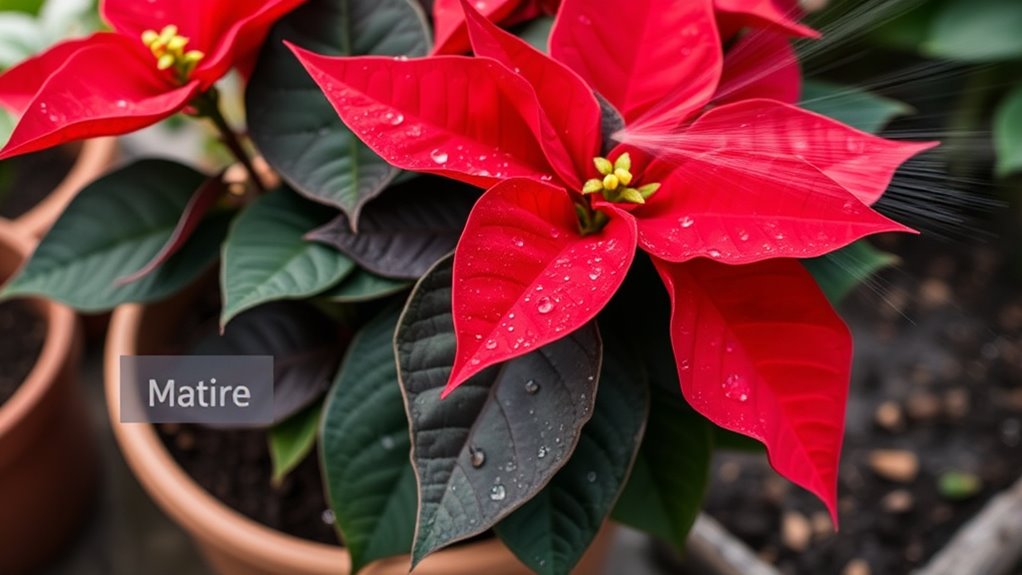
Proper watering and humidity control play a key role in keeping your poinsettia vibrant and healthy. Water your plant only when the top inch of soil is dry to the touch, ensuring thorough watering until excess drains from the bottom. Always remove any decorative foil or cover before watering to prevent water from accumulating and causing root rot. Use room temperature water to avoid shocking the roots, and avoid overwatering, as soggy soil can lead to root damage. To maintain proper humidity, place your poinsettia on a tray filled with water and pebbles or use a humidifier, especially during dry winter months. Self Watering Planters can also help maintain consistent moisture levels and reduce the risk of overwatering. Incorporating innovative materials into your care routine can further enhance plant health and resilience. Additionally, monitoring humidity levels ensures your poinsettia remains in optimal conditions, preventing leaf drop and promoting lush growth. Light misting can also help keep moisture levels up and prevent leaf drying caused by indoor dry air. To optimize plant health, consider adjusting your environment to reduce dry air and support healthy foliage growth.
Pruning and Repotting to Promote Healthy Growth
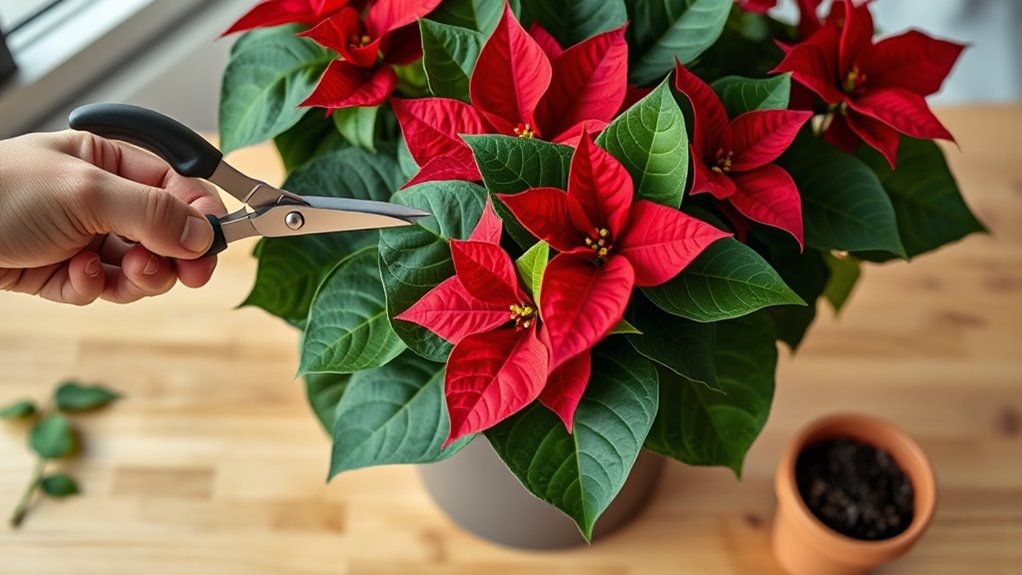
Pruning and repotting are essential steps to keep your poinsettia healthy and vibrant. Pruning involves cutting back stems to 4-6 inches in early spring, encouraging bushier, fuller growth. Remove dead or damaged stems during pruning to promote healthy new growth and prevent disease. Incorporating proper plant maintenance techniques can also improve your overall plant care routine. Regularly pinch back new growth during the season to develop a compact, rounded shape. Repot the plant into a slightly larger container with well-draining soil once the roots become crowded, typically after flowering. This refreshes the soil and provides space for the roots to expand. Additionally, watering practices play a crucial role in maintaining your poinsettia’s health and should be adjusted based on the plant’s needs. Ensuring proper soil conditions can further enhance the plant’s vitality and flowering potential. Proper pruning and repotting ensure your poinsettia remains healthy and prepares it for future flowering. Monitoring light conditions and providing adequate indirect light can also support optimal growth and flowering cycles.
Techniques for Reflowering Your Poinsettia

Reflowering your poinsettia requires a dedicated lighting schedule that mimics natural day-night cycles. Starting in early October, ensure your plant gets 12-14 hours of complete darkness each night by covering it with a box or light-blocking material. High light requirements are essential for triggering the flowering process. This dark period triggers the reflower process and stimulates bract development. During the day, provide bright, indirect light and maintain temperatures around 65°F to promote healthy growth and vibrant coloration. Consistency is key; continue the dark period for 6-8 weeks until the bracts begin to show color, usually by mid-November. Proper light control during this time encourages flowering and ensures successful reflowering. Additionally, maintaining the right temperature range can influence blooming success and overall plant health. Once the bracts develop their color, you can resume normal light and watering routines.
Tips for Safe and Effective Care Throughout the Year
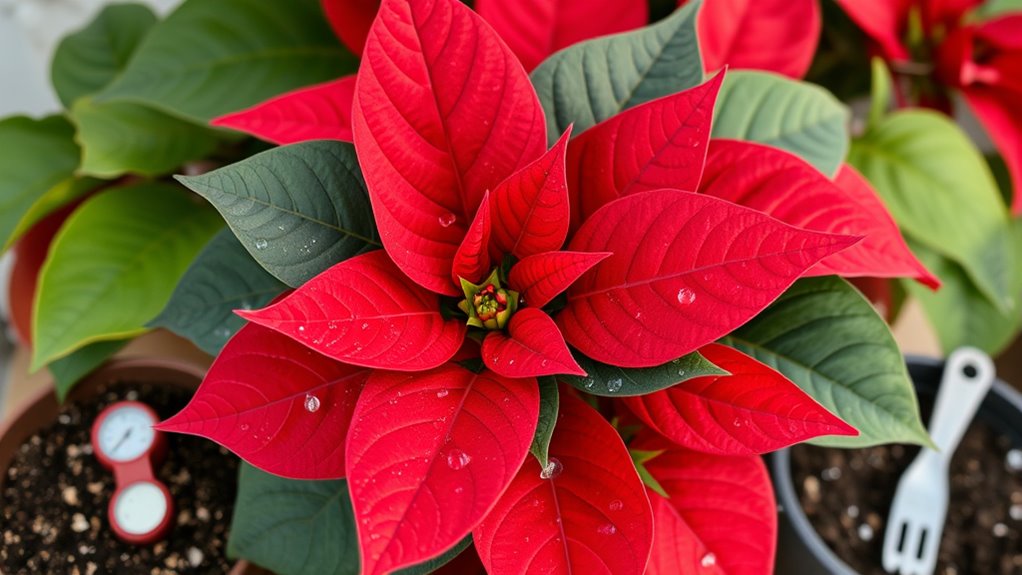
To keep your poinsettia healthy and vibrant year-round, it’s essential to provide consistent care that balances light, water, and temperature. Place it in bright, indirect light for at least 6 hours daily to sustain its color. Incorporate natural materials like wood or linen in nearby decor to enhance the plant’s rustic charm. Water only when the top inch of soil feels dry, ensuring thorough watering without standing water. Maintain indoor temperatures between 60°F and 70°F, and keep the plant away from drafts, cold windows, or heat sources. During winter, increase humidity with trays or misting to prevent leaf drop. Regular pruning and repotting in early spring promote healthy growth. To encourage re-blooming, follow specific light and dark cycle routines in October, which can be crucial for flowering success. These cycles are closely linked to photoperiodism, which influences flowering in many plants. Additionally, choosing appropriate watering practices helps prevent root rot and keeps the soil properly moist. Proper soil drainage is also vital to avoid waterlogging and maintain healthy roots. These practices guarantee your poinsettia stays healthy and beautiful throughout the year.
Frequently Asked Questions
How Do You Keep Poinsettias Alive Past Christmas?
To keep your poinsettia alive past Christmas, you need to provide the right light, water, and temperature. Place it in bright, indirect light and water only when the top inch of soil feels dry.
Keep the temperature steady between 60°F and 70°F, and avoid drafts.
Prune it back to 4-6 inches after the holidays, and start giving it 14-16 hours of darkness nightly in October to encourage reblooming.
What Do People Do With Poinsettias After the Holidays?
After the holidays, you often prune and repot your poinsettia to encourage healthy growth. You might keep it indoors as a houseplant, providing proper light, water, and humidity, or transplant it outdoors if your climate allows.
Some people continue caring for and fertilizing their poinsettia to enjoy it year-round, while others induce reflowering by managing light and dark periods starting in October to extend its festive beauty.
How Long Will a Poinsettia Typically Last Indoors?
A poinsettia typically lasts indoors for about 2 to 3 months.
If you provide it with enough light, proper watering, and maintain the right temperature and humidity, it can sometimes stay attractive for up to six weeks or longer.
Keep an eye on its health and make environmental adjustments as needed.
With good care, you might enjoy your poinsettia well beyond the usual holiday season.
What Is the Best Advice About a Reblooming Poinsettia?
Like a vintage typewriter, a reblooming poinsettia needs special care. To encourage it, give your plant 14-16 hours of complete darkness each night starting in early October for about six weeks.
During the day, put it in bright, indirect sunlight for 8-9 hours. Keep nighttime temperatures around 65°F and avoid any light exposure during the dark period.
Once buds show color, resume normal care to enjoy its festive beauty again.
Conclusion
Believe it or not, keeping your poinsettia alive year-round isn’t just luck—it’s about consistent care. Many say you can reflower it by controlling light and temperature, but science suggests it’s more about understanding its natural cycle. With proper watering, pruning, and patience, you might just prove that your holiday plant can thrive long after December. So, stay attentive, follow these tips, and enjoy your poinsettia’s beauty all year.
